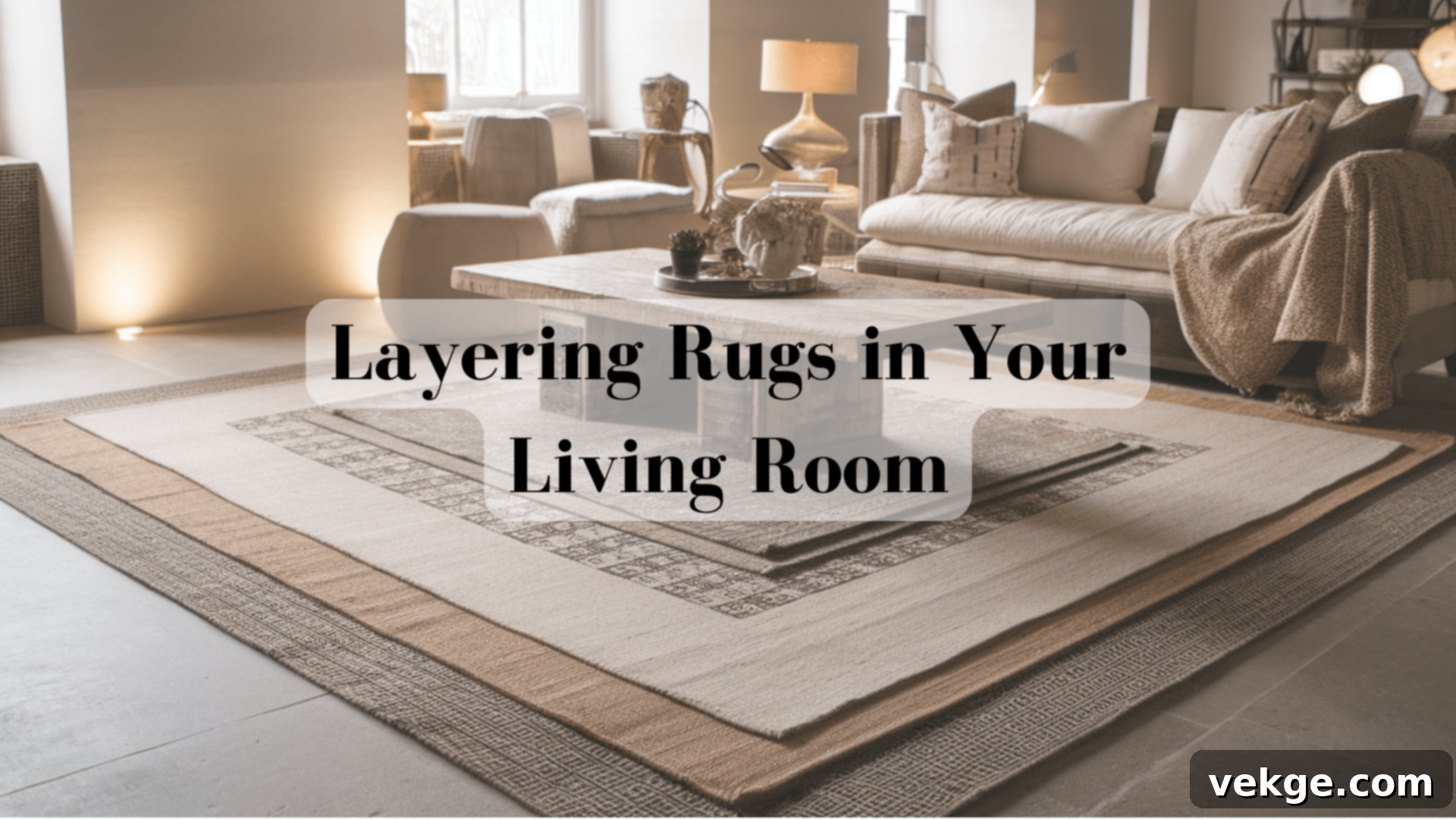Master the Art of Layering Rugs: Transform Your Living Room with Depth & Style
Are you yearning for a living room that feels instantly more welcoming, cozy, and bursting with personality? Look no further than the surprisingly simple, yet incredibly effective, design technique of layering rugs. This method isn’t just about placing one rug on top of another; it’s a clever design strategy that introduces incredible depth, rich texture, and palpable warmth, instantly elevating any space from ordinary to extraordinary.
While many homeowners are captivated by the look of layered rugs, they often hesitate, unsure of the “rules” or how to achieve a harmonious balance. The fear of making a design misstep can be paralyzing, leading to missed opportunities for creating truly unique and inviting interiors. But what if there was a simple roadmap to mastering this stylish trend?
As an interior designer who has helped hundreds of clients transform their spaces using these very living room-style methods, I’m thrilled to share my insider knowledge with you. This comprehensive guide will dispel common myths and empower you with the confidence to layer rugs like a seasoned professional. By the end, you’ll be equipped with practical advice and creative inspiration to revitalize your own home.
In this ultimate guide, you’ll discover:
- Which rug sizes work best together to create visual balance and define your space effectively.
- How to mix patterns and textures successfully to add visual interest without overwhelming your room.
- Expert tips for keeping layered rugs in place, ensuring both safety and a polished, professional look.
- Inspiring styling ideas and specific rug combinations to spark your creativity and suit any decor style.
- Common mistakes to avoid, saving you time, effort, and potential design headaches.
Get ready to infuse your living room with unmatched comfort and style. Let’s dive in!
Choosing the Right Base Rug: The Foundation of Your Layered Look
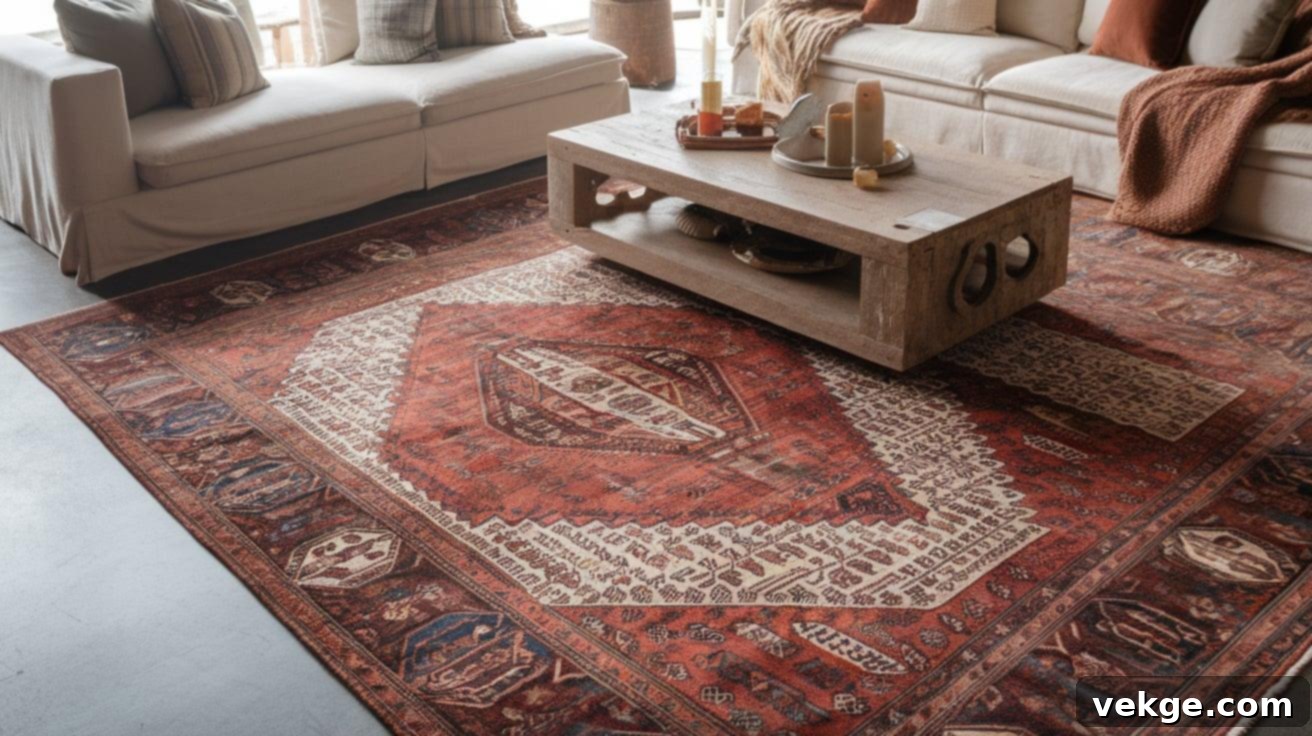
Every masterpiece needs a solid foundation, and your layered rug design is no different. The bottom layer, or base rug, serves as the anchor for your entire room. It grounds your furniture, defines the main seating area, and sets the tone for the layers to come. I always tell my clients that getting this first rug right is absolutely crucial; it makes the subsequent steps much easier and ensures a cohesive, intentional design.
1. Size Matters Most: Go Big or Go Home
The single most common mistake I see homeowners make is choosing a base rug that is too small. A tiny rug can make your entire living room feel disjointed and unfinished, as if the furniture is floating rather than being part of a unified space. To truly anchor your room, your base rug needs to be generously sized.
Here’s a simple rule of thumb: the rug should extend at least 6 to 12 inches beyond your furniture on all sides, ensuring that at least the front legs of all primary seating pieces (sofa, armchairs) rest comfortably on the rug. Ideally, for a truly luxurious and well-grounded feel, all four legs of your main furniture pieces should sit on the base rug. For most standard living rooms, this often translates to an 8×10 or 9×12 rug, but always measure your space and furniture layout meticulously before purchasing.
2. Pick Simple, Durable Materials for Longevity
Given its role as the foundation, your base rug needs to be robust and able to withstand daily foot traffic and the weight of furniture. Opt for materials that offer durability, a subtle texture, and a relatively low profile. I highly recommend these options for their practicality and aesthetic appeal:
- Natural Jute: Jute adds an organic, earthy texture that instantly brings warmth and a relaxed vibe to any room. Its neutral tone pairs beautifully with virtually any decor style and color palette, making it incredibly versatile. It’s also surprisingly durable and eco-friendly.
- Flat-weave Wool: Known for its exceptional resilience and natural stain resistance, flat-weave wool is an excellent choice for a base rug. It can handle heavy furniture without showing significant indentations and provides a soft, yet firm, foundation. Its low pile also makes it easy to clean.
- Sisal: Perfect for high-traffic areas, sisal is an incredibly tough and durable natural fiber. It offers a distinct, natural texture and a clean, understated look. While it’s not as soft underfoot as wool, its strength makes it ideal for a base layer that needs to endure a lot of activity.
- Low-Pile Cotton Blend: A tightly woven cotton or cotton blend flatweave can also serve as an excellent base. It’s often more affordable, easy to clean, and comes in a wide range of neutral colors, providing a soft yet stable surface.
3. Colors That Work: The Power of Neutrality
For your base rug, think subtle and sophisticated. Keep the colors simple and understated to allow your top layer to truly shine. Soft browns, warm grays, creams, or even light beiges make the best foundation. Why? Because they create a calming backdrop that won’t compete with the patterns or bolder colors of your top rug. These neutral tones act as a versatile canvas, ensuring your layered look feels cohesive and elegant, rather than chaotic. They also provide a sense of expansive space, making your room feel larger and more open.
A Few More Essential Tips for Your Base Rug:
- Ensure it Lies Completely Flat: A wrinkled or bunched base rug is not only unsightly but also a tripping hazard. Make sure it’s taut and smooth across your floor. A good quality rug pad underneath will help achieve this.
- Confirm it Can Handle Furniture Weight: Choose a material and weave that won’t easily compress or show deep indentations from heavy furniture, maintaining its aesthetic appeal over time.
- Look for Low Shedding Materials: While natural fibers might shed a little initially, excessive shedding can be a nuisance, especially under another rug. Opt for materials known for their low maintenance.
Once you’ve meticulously sorted out your base rug – ensuring it’s the right size, material, and color – we can move on to the truly exciting part: choosing your top layer!
Adding the Top Layer: Where Personality and Style Converge
Now, this is where you get to unleash your creativity and infuse your room with unique character. Your top rug is the star of the show; it brings life, visual interest, and a pop of personality through its colors, patterns, and textures. This layer is your opportunity to express your style, define a seating area, or introduce an accent that ties the whole room together. But don’t worry – I’m here to guide you, helping you avoid any common design pitfalls and ensure a harmonious result.
1. Size Guidelines for Perfect Proportion
The golden rule for the top layer is simple: it must be smaller than your base layer. This contrast in size is what creates the “layered” effect and allows both rugs to be seen and appreciated. I generally suggest going 2 to 3 feet smaller on each side. For example, if your base rug is a generous 9×12, a 6×9 or even a 5×8 rug would work wonderfully as your top layer. This ensures a visible border of the base rug, creating a beautiful frame that defines your main conversation area and adds a sense of spaciousness. The smaller size also allows for more flexibility in pattern and color choices without overwhelming the room.
2. Playing with Patterns: Your Design Signature
The top rug is your prime opportunity to introduce compelling patterns. With a neutral base beneath, you have the freedom to be bold and expressive. Here’s what works exceptionally well for top layers, offering various styles and visual impacts:
- Stripes: Versatile and timeless, stripes can make a room feel bigger and longer, or wider, depending on their orientation. They add a classic, tailored look and can range from subtle pinstripes to bold, wide bands.
- Geometric Shapes: Modern and dynamic, geometric patterns like squares, circles, diamonds, or abstract shapes add a contemporary edge and architectural interest. They can bring a structured yet playful vibe to your space.
- Floral Designs: From delicate botanicals to lush, oversized blooms, floral patterns infuse warmth, softness, and an organic touch. They can evoke a sense of romance, tradition, or a relaxed garden aesthetic.
- Persian-Style Patterns: Intricate, rich, and full of history, Persian or Oriental-inspired patterns add a touch of timeless class, luxury, and cultural depth. Their often muted, complex color palettes work surprisingly well with modern and traditional decor alike, bringing a collected-over-time feel.
- Abstract Designs: For a truly contemporary and artistic statement, abstract patterns offer a fluid, expressive energy. They can introduce a focal point without being overly thematic.
3. Color Combinations That Work: Tying it All Together
When selecting the color palette for your top rug, look to your existing room decor for inspiration. Your top rug should include at least one (and ideally two or three) of the shades already present in your furniture, artwork, curtains, or throw pillows. This creates a cohesive narrative, making the rug feel like an integral part of the room, rather than an afterthought. For instance, if your room features blue curtains and some cream throw pillows, a rug with a pattern incorporating shades of blue and cream will effortlessly tie everything together, creating visual harmony and a polished look.
You can also use the top rug to introduce a new accent color, as long as it complements the overall scheme. Think of it as the artistic element that pulls various design threads into a beautiful, unified tapestry.
4. Smart Pattern Mixing Tips for Visual Harmony
Mixing patterns can feel daunting, but with a few guidelines, you can achieve a sophisticated and balanced look:
- Vary Scale: The most important rule! If your base rug has a subtle, tight pattern (or is solid), choose a top rug with a larger, bolder pattern. Conversely, if your base has a large, abstract pattern (less common for base rugs but possible), opt for a smaller, more intricate pattern on top. Avoid pairing two patterns of similar scale, as they will compete.
- Match Light and Dark Shades: Ensure there’s a good contrast in lightness or darkness between the two rugs. A light base with a darker top, or vice versa, provides definition. Also, look for a shared “value” – a similar level of light or dark – in some of the colors.
- Plain Base, Bold Top: This is a foolproof combination. A solid or subtly textured base rug provides the perfect understated stage for a vibrant, patterned top rug to truly pop without overwhelming the senses.
- If Unsure, Stick to Two Main Colors: When in doubt, limit your top rug’s primary colors to two or three that echo your room’s existing palette. This simplifies the mixing process and ensures a refined outcome.
- Introduce Different Styles: Don’t be afraid to mix a geometric pattern with a floral, or a striped rug with an abstract design. The key is to vary the scale and ensure complementary colors.
Quick Test for Visual Confirmation: Once you have your base rug down, take a photo of your room. Then, if possible, hold up your chosen top rug (or a sample swatch) in the picture, or digitally superimpose it. This visual trick can instantly help you determine if the colors, patterns, and scales work together harmonently before you commit to a purchase. It’s like having a sneak peek at your finished design!
Playing with Shapes and Sizes: Creative Combinations for Unique Spaces
Beyond choosing the right patterns and colors, experimenting with different rug shapes and their placement can dramatically impact the feel and functionality of your layered design. This is where you can truly express your personal style and add unexpected visual interest, breaking away from traditional layouts.
1. Rectangle on Rectangle: The Classic Foundation with a Twist
This is undeniably the most common and versatile pairing, offering a clean, structured look. However, simple placement variations can make all the difference, transforming it from basic to bespoke. Don’t just center it – get creative:
- Line Them Up at One Corner: Instead of perfect centering, align one corner of your top rug with a corresponding corner of the base. This creates an asymmetrical yet balanced look, especially effective in defining a specific zone like a reading nook or a conversation area within a larger room.
- Center the Top Rug: The most straightforward approach, centering the top rug over the base creates a symmetrical, formal, and organized aesthetic. This works well in traditional or minimalist spaces.
- Angle the Top Rug for a Fresh Look: Placing the smaller top rug at a slight angle (e.g., 45 degrees) over the rectangular base instantly introduces dynamism and a modern, playful vibe. It breaks up straight lines and draws the eye, making the room feel more energetic and less rigid.
- Offset Placement: Shift the top rug slightly off-center along one axis (e.g., closer to the sofa). This creates a subtle asymmetry that feels curated and less “staged,” adding an element of surprise.
2. Round on Square/Rectangle: Softness Meets Structure
This is a combination I absolutely adore using in my designs. A round rug layered on top of a square or rectangular base creates a beautiful contrast, introducing softness and fluid lines against more rigid geometric forms. This pairing brings a sense of harmony and organic appeal, breaking the monotony of rectangular furniture and rooms.
It works exceptionally well in various scenarios:
- Under Coffee Tables: A round rug perfectly frames a round or square coffee table, drawing attention to the central gathering point and creating a cohesive vignette.
- In Room Corners: To soften a stark corner or create a cozy, defined zone for an armchair and side table, a round rug can be incredibly effective.
- To Highlight Sitting Areas: In open-plan spaces, a round rug can subtly delineate a specific seating or reading area without the need for physical barriers, adding an intimate feel.
- Beneath a Dining Table: While less common for layering, a round rug can soften the edges of a square dining area, especially if the table is round.
3. Size Ratios That Work for Visual Appeal
Achieving the best-layered look isn’t just about putting two rugs together; it’s about mindful proportion. These guidelines ensure visual balance and a polished finish:
- The Top Rug Covers About 2/3 of the Base: This ratio is often cited as ideal for creating a clear layering effect without dwarfing the top rug or making the base disappear. It ensures both rugs are prominently featured.
- Leave 18-24 Inches of the Base Showing: This provides a generous “frame” around your top rug, allowing the base rug’s texture or subtle pattern to be appreciated and grounding the entire arrangement. A smaller border can look cramped.
- Keep Furniture Legs Either All On or All Off the Top Rug: For stability and aesthetic consistency, ensure that the legs of your furniture are either fully on the top rug (if it’s large enough for the main pieces) or entirely off it, resting only on the base rug. Avoid having some legs on and some off, as this can make furniture wobble and look messy.
4. Small Space Solutions: Maximizing Style in Compact Areas
Working with a tiny room doesn’t mean you have to forgo the layered rug trend. In fact, clever layering can make small spaces feel more expansive and thoughtfully designed:
- Use a Round Rug on Top to Save Space: Round rugs take up less visual space than rectangles and can help soften the rigid lines of a small room, making it feel less cramped and more inviting.
- Place Rugs at an Angle: Angling a top rug in a small room can create the illusion of more space by drawing the eye diagonally across the room, making it feel wider or longer.
- Let the Smaller Rug Define a Reading Nook: In an open-concept small space, use the top rug to clearly delineate a specific functional zone, such as a cozy reading corner by a window or a dedicated workstation. This brings order and purpose to a compact area.
- Opt for Lighter Colors: Lighter, more neutral colors for both layers can visually expand a small room.
5. Specific Shape Tips for Intentional Design
- Square Rugs Work Well Under Square Coffee Tables: This creates a harmonious, matching aesthetic that feels very intentional and pulls the central elements of your seating area together.
- Oval Rugs Soften Rooms with Lots of Straight Lines: If your room is filled with rectangular furniture, crisp architectural details, or linear patterns, an oval top rug can introduce much-needed curvilinear elements, adding softness and flow.
- Hide or Show More of the Base by Shifting the Top Rug: Don’t be afraid to adjust the top rug’s position. Slide it slightly forward, backward, or to the side to reveal more (or less) of the base rug, creating different visual effects and adapting to your furniture arrangement.
- Utilize Runners: A runner layered over a large rectangular base can define a path or segment a long room, adding practical and aesthetic value.
Remember: There’s no single “right” way to layer rugs. The beauty of this technique lies in its flexibility and personal expression. Move things around, experiment with different orientations, and step back to observe. Trust your eye – you’ll know when you’ve found the perfect arrangement that feels harmonious and brings joy to your space.
Styling Ideas and Inspiration: Transforming Your Space
Now that you understand the principles, let’s explore some inspiring styling ideas to kickstart your creativity. These combinations leverage different textures, patterns, and colors to create distinct moods and aesthetics, showing you the versatility of rug layering.
1. Natural Textures Mix: Earthy Serenity
Imagine a large, robust jute rug as your base, paired with a soft, inviting wool rug in a calming cream or oatmeal hue on top. This combination creates incredible depth and tactile interest without being visually overwhelming. I love this duo because it effortlessly brings the serenity of the outdoors in while maintaining a wonderfully cozy and sophisticated atmosphere. The slightly rough, irregular weave of jute beautifully contrasts with the plush, smooth softness of wool, making your space feel rich, layered, and genuinely inviting.
- Jute’s inherent grip helps to hold the softer wool rug securely in place, minimizing slippage.
- This versatile pairing works seamlessly in a wide range of styles, from bohemian and rustic to modern minimalist and classic coastal.
- The appeal comes primarily from the interplay of textures, allowing for a refined look even with a subdued color palette.
- Perfect for: Family rooms, sunrooms, casual living spaces, or any area where comfort and an organic feel are paramount.
2. Bold on Basic: Dynamic Contrast
Start with a substantial, solid-colored gray or charcoal base rug, then introduce a smaller top rug featuring a bold, eye-catching pattern (perhaps a striking black and white geometric or an abstract design with vibrant accents). This approach creates a powerful focal point where the pattern truly pops, yet the overall look remains balanced and sophisticated. The expansive, neutral base prevents the bold pattern from overwhelming your room, instead providing a steady anchor that allows the top rug to make a confident design statement.
- Dramatic patterns achieve maximum impact against a neutral, understated background.
- This setup makes it incredibly easy to swap out the top rug seasonally or whenever you desire a fresh new look, offering cost-effective decor updates.
- Effectively helps to define specific conversation areas within an open-plan layout.
- Perfect for: Modern living rooms, home offices seeking a touch of creativity, or contemporary dining areas that need a vibrant accent.
3. Vintage Over Modern: Timeless Elegance
Layer a smaller, beautifully aged vintage-style rug (think a faded Persian, Oushak, or Moroccan Beni Ourain) over a simple, clean-lined modern base rug in a solid neutral tone. This exquisite mix adds character, soul, and a sense of history while ensuring your space remains current and fresh. The rich, often muted patterns and authentic wear of older-looking rugs bring an unmatched warmth and lived-in comfort, beautifully contrasting with the clean lines of contemporary furniture and minimalist spaces. It’s a masterful blend of old and new.
- The juxtaposition of old and new elements creates a captivating tension and sophisticated balance.
- Instantly adds a feeling of warmth, depth, and comforting history to otherwise sleek or modern rooms.
- Each vintage rug tells a unique story, imbuing your space with unparalleled character and personality.
- Perfect for: Eclectic study rooms, formal living rooms that crave depth, or entryways designed to make a grand, welcoming statement.
4. Monochrome Magic: Subtle Sophistication
Achieve subtle depth and refined visual interest by using two rugs in different shades or textures of the same color family. For instance, I might suggest a light gray base rug with a slightly darker gray top rug that features a subtle, tone-on-tone pattern or a more pronounced texture (like a plush shag). This creates a sophisticated, monochromatic scheme that adds visual layering and dimension without introducing conflicting colors. The result is a calm, cohesive, and elegant space that feels incredibly chic.
- Generates sophisticated visual interest and layering without any risk of color clashes.
- Using varying shades of the same color can trick the eye, making smaller spaces feel more expansive and open.
- Adds an immediate sense of understated elegance and high-end design to even the simplest rooms.
- Perfect for: Bedrooms, minimalist living rooms, studio apartments, or any space where a serene and uncluttered aesthetic is desired.
5. Color Block Effect: Dynamic Definition
For a bold and artistic statement, place a solid-colored rug (perhaps in a vibrant accent color or a deeper, contrasting neutral) at a distinct angle over a larger, neutral base rug. This technique is fantastic for drawing the eye, creating clear zones within an open-plan area, and making your room feel more organized and purposefully designed. The angled placement introduces a sense of movement and energy, preventing the space from feeling too static or predictable.
- Effectively creates clear visual zones and pathways in larger, open-plan spaces, enhancing functionality.
- The dynamic, angled arrangement makes rooms feel more energetic, contemporary, and visually engaging.
- Often, solid-colored rugs are easier to clean and maintain than highly patterned ones, offering practical benefits.
- Perfect for: Open-plan living areas, studio apartments, large living rooms that need clear delineation, or artistically inclined homes.
Stylish Rug Combinations for Living Room Layering: Visual Inspirations
To further illustrate the power of layered rugs, here are specific, tried-and-true combinations that offer distinct styles and benefits. Each pairing is designed to spark your imagination and help you envision the possibilities for your own home.
1. Seagrass and Persian: Casual Elegance
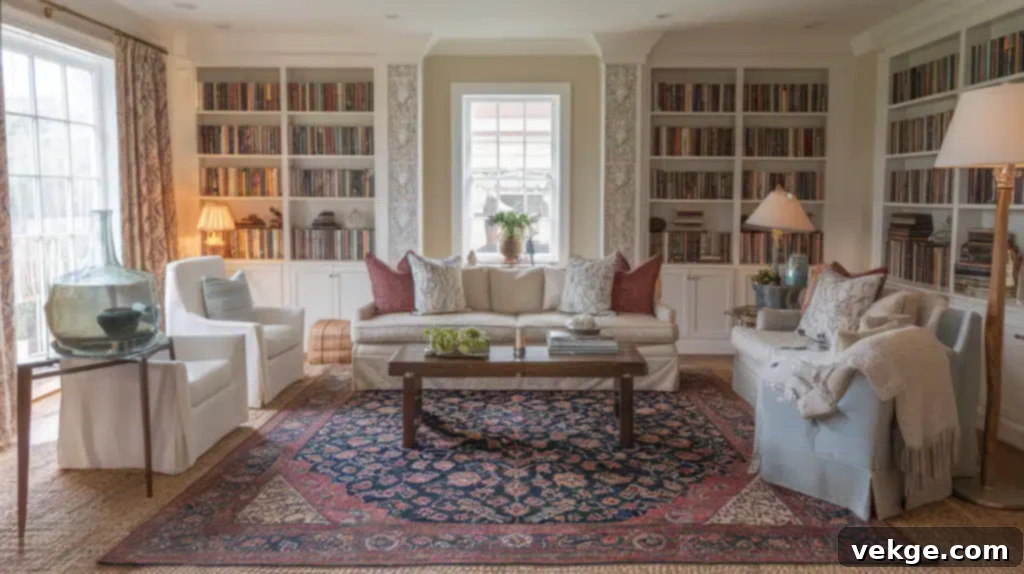
A natural, textured seagrass base rug combined with a richly patterned, often jewel-toned, Persian or Oriental rug on top creates a perfect fusion of casual comfort and refined sophistication. The clean, earthy lines of the seagrass provide a grounding, organic foundation, while the intricate patterns and deep, traditional colors of the Persian rug add a layer of history, artistry, and luxurious warmth, telling a compelling visual story.
- The exceptionally durable seagrass base is ideal for high-traffic areas, protecting your floors and providing stability.
- The dense, complex patterns of Persian rugs are excellent at camouflaging everyday wear, spills, and dirt.
- Natural fibers like seagrass can contribute to improved air quality by absorbing moisture and filtering airborne particles.
- Perfect for: Traditional homes, formal living rooms, library spaces, or any setting where a blend of natural texture and classic artistry is desired.
2. Solid Wool and Geometric: Modern Comfort

Begin with a thick, plush wool rug in a calming cream, light gray, or greige as your base, then top it with a smaller rug featuring a crisp, contemporary geometric pattern (e.g., chevrons, diamond repeats, or abstract lines). This combination masterfully blends modern style with ultimate comfort. The soft, luxurious wool base provides a foundational layer of warmth and coziness, while the sharp, defined lines of the geometric pattern introduce a fresh, contemporary aesthetic, creating visual interest without overwhelming the space. It’s a balance of softness and structure.
- The substantial wool base offers excellent sound absorption, contributing to a quieter, more tranquil room.
- Sharp, clean geometric patterns instantly infuse a modern, updated touch, perfect for contemporary interiors.
- Both wool and many synthetic geometric rugs are known for being relatively easy to clean and maintain with regular vacuuming.
- Perfect for: Contemporary homes, urban apartments, art deco-inspired spaces, or living rooms that lean towards a sleek, sophisticated modern vibe.
3. Jute and Tribal: Bohemian Rhapsody
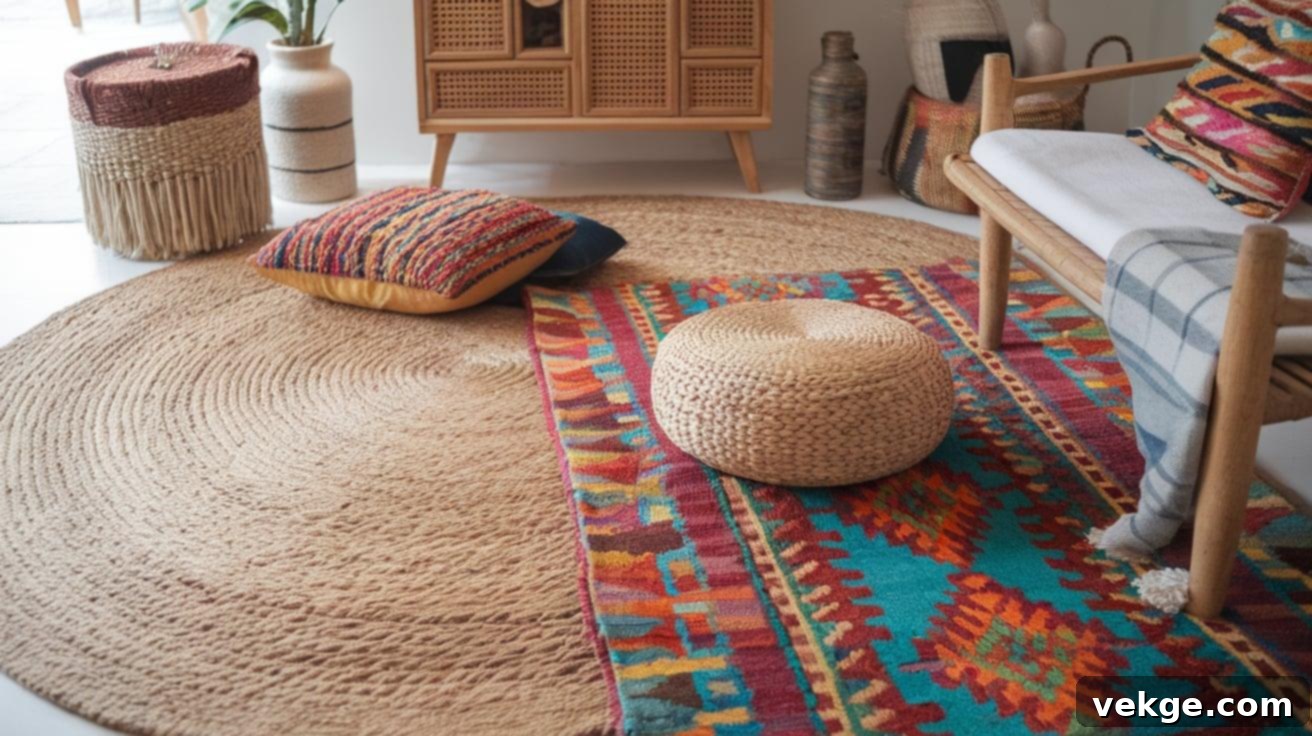
Layer a richly patterned, often hand-knotted, tribal rug (such as a Kilim, Moroccan Boucherouite, or a Southwestern-inspired design) over a chunky, textural jute base. The natural, understated tones and rough-hewn texture of the jute beautifully complement the bold, often earthy patterns and vibrant colors of tribal designs. This pairing creates a wonderfully balanced, worldly, and well-traveled feel that remains grounded and incredibly inviting, perfect for free-spirited decor.
- The strong, contrasting textures of jute and tribal wool create immediate visual and tactile intrigue.
- The earthy, natural tones of jute act as a perfect neutral backdrop, allowing the rich, often warm colors of tribal rugs to pop.
- This combination evokes a sense of history and adventure, contributing to a bohemian or “collected-over-time” aesthetic.
- Perfect for: Bohemian spaces, eclectic rooms, global-inspired homes, or artistic environments that celebrate handcrafted beauty.
4. Sisal and Moroccan: Minimalist Oasis
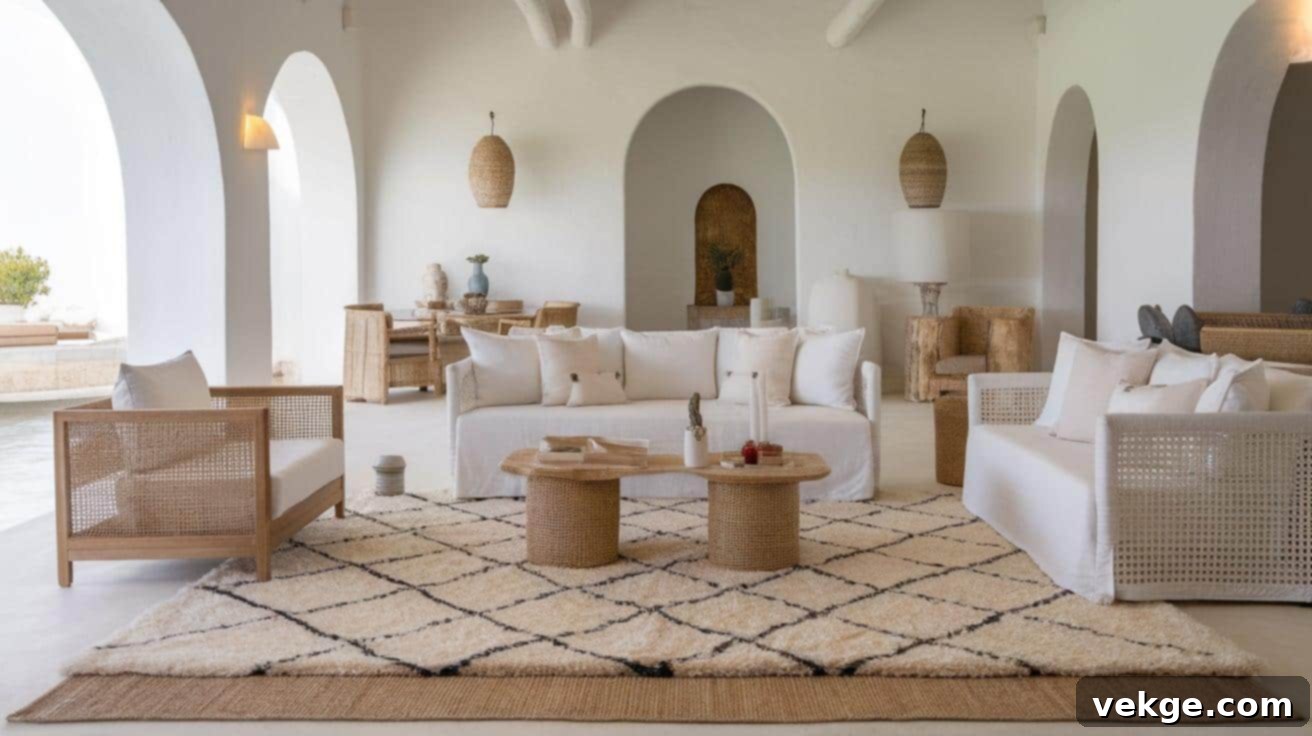
Combine the crisp, clean lines and natural texture of a sisal base with the plush, often ivory or off-white, organic patterns of a Moroccan-style rug (like a Beni Ourain). The minimalist elegance of sisal, with its tight weave and understated aesthetic, provides a serene backdrop for the soft, geometric, and often high-pile designs of Moroccan rugs. This pairing creates incredible depth and luxurious comfort without any visual clutter, making a room feel bright, spacious, and invitingly soft.
- Sisal’s inherent coarse texture provides excellent slip resistance, ensuring the top rug stays in place.
- The predominantly white or cream Moroccan rug significantly brightens the room, enhancing natural light and making the space feel larger.
- The plushness and organic patterns of Moroccan rugs add a wonderful layer of softness and warmth underfoot.
- Perfect for: Mediterranean-inspired homes, coastal retreats, bright and airy living areas, or minimalist interiors seeking a touch of warmth and texture.
5. Flatweave and Shag: Plush Harmony

For a bold statement in textural contrast, combine a sturdy, low-profile flatweave base rug (perhaps a solid cotton or wool) with a luxurious, high-pile shag rug on top. This pairing is all about celebrating texture in a big way, making your room feel incredibly rich, opulent, and inviting without relying on complex patterns or vibrant colors. The flatweave provides a stable, understated foundation, allowing the decadent shag to become the star, offering unparalleled softness and warmth underfoot.
- The dramatic difference in pile height and texture creates dynamic visual and tactile depth.
- Shag rugs are synonymous with warmth, comfort, and a cozy, sink-your-toes-in feel, perfect for relaxation zones.
- Both types of rugs, especially in solid colors, can be relatively easy to rearrange for new looks or to simplify cleaning.
- Perfect for: Modern homes, minimalist spaces that need warmth, cozy dens, or any area where tactile luxury is a priority.
6. Cotton and Kilim: Cultured & Casual
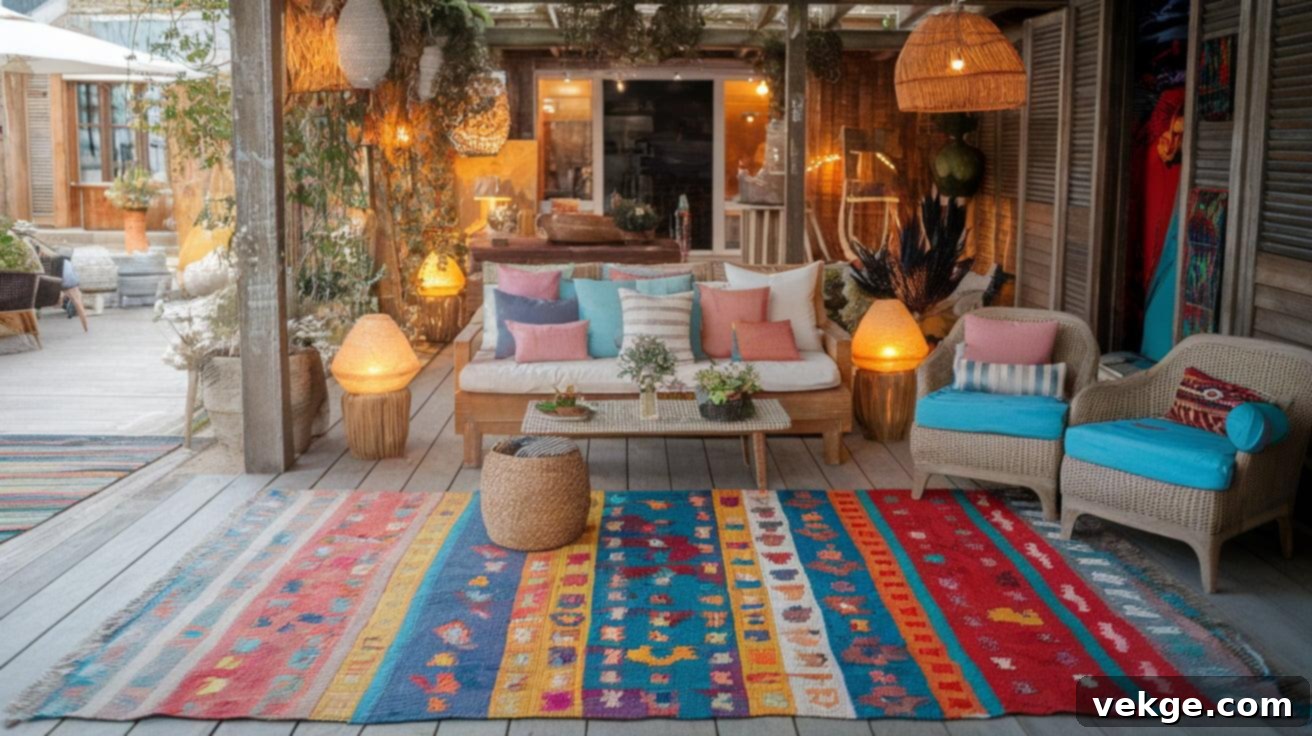
A simple, soft cotton dhurrie or flatweave rug as your base, topped with a vibrant, intricately patterned Kilim rug, creates a look that is both casual and deeply cultured. The unpretentious nature of the cotton provides a clean, breathable backdrop, allowing the rich, often geometric patterns and diverse color palettes of the Kilim to take center stage. This combination exudes an effortless, eclectic charm, perfect for infusing a space with global flair and artisanal character.
- Both cotton dhurries and Kilim rugs are typically lightweight and relatively easy to clean and rotate.
- Kilim rugs are celebrated for their rich cultural character, often handwoven with traditional patterns and vibrant natural dyes.
- This pairing allows for great seasonal flexibility; a lighter cotton base can be paired with a bright Kilim for summer, and a heavier, darker Kilim can be swapped in for cooler months.
- Perfect for: Casual living rooms, summer homes, creative studio spaces, or homes that embrace a global or bohemian aesthetic.
7. Cowhide on Classic: Unexpected Modern Rustic
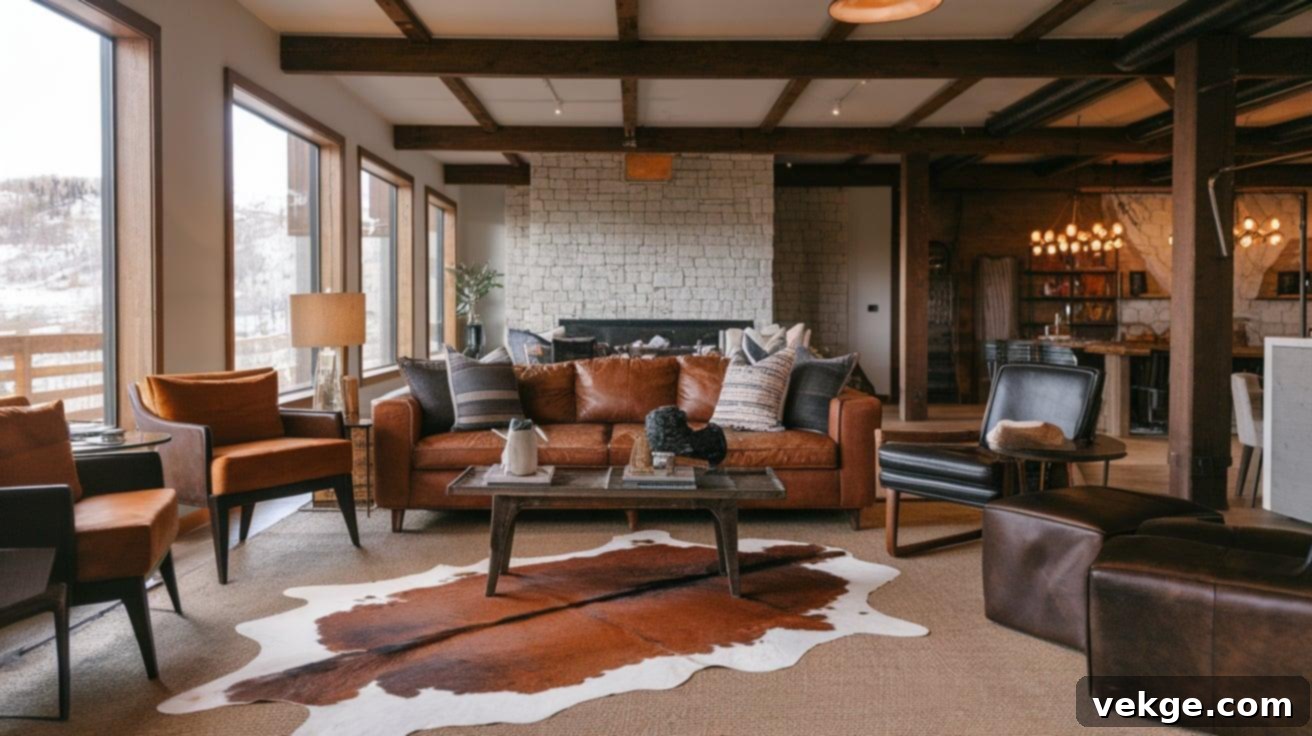
For a truly distinctive and modern rustic look, place an irregularly shaped cowhide rug over a classic rectangular wool or flatweave rug in a solid, neutral color (e.g., gray, cream, or brown). This unexpected combination introduces organic, sculptural shapes that beautifully break up the straight lines of traditional furniture and rooms. The natural patterns and unique silhouette of the cowhide add a touch of untamed elegance and texture, keeping the space sophisticated yet intriguing.
- The natural, irregular shapes of the cowhide rug provide a striking contrast to the structured lines of the base rug and surrounding furniture.
- Cowhide rugs inherently add warmth, a touch of luxury, and a distinctive natural element to modern or minimalist spaces.
- The unique shape and pattern of a cowhide create an instant focal point, drawing the eye and making a memorable statement.
- Perfect for: Mountain homes, modern farmhouses, loft spaces, masculine studies, or any contemporary interior seeking a unique, naturalistic accent.
Essential Tips for Layering Rugs in Your Living Room: Practical Advice for Success
Beyond aesthetics, practical considerations are key to a successful and long-lasting layered rug setup. These essential tips will ensure your design is not only beautiful but also safe, functional, and easy to maintain.
1. Keep Your Base Rug in Place with a Quality Pad
This is non-negotiable! I’ve witnessed countless beautiful layered setups undermined by shifting, bunching rugs. A good rug pad is truly the unsung hero of rug layering. Placed directly under your base rug, a quality pad grips both the floor and the rug itself, preventing movement and extending the life of your precious rugs. Don’t skip this step!
- Stops Both Rugs from Shifting: A non-slip pad ensures stability for both the base and, indirectly, the top rug.
- Adds Extra Cushioning: Enhances comfort underfoot, making your layered area feel more luxurious.
- Makes Cleaning Easier: Prevents rugs from migrating during vacuuming, making the task much more efficient.
- Extends Rug Life: Reduces wear and tear on both the rug fibers and your flooring by providing a protective barrier.
- Protects Floors: Prevents rug colors from bleeding onto your hard floors and shields them from scratches.
2. Mind the Pile Height: Smooth Transitions are Key
The thickness, or “pile height,” of your rugs is a critical factor for both aesthetics and functionality. I strongly suggest using a low-pile or flat-weave rug as your base, then adding a thicker, higher-pile rug (like a shag, plush wool, or Moroccan rug) on top. This creates a smooth, gradual transition between the layers and prevents several issues.
- Creates Smooth Transitions: A clear difference in pile height looks more intentional and prevents a “lumpy” appearance.
- Prevents Tripping Hazards: A low-pile base minimizes the height difference, reducing the risk of tripping over the edge of the top rug.
- Makes Doors Open Easily: Ensures that nearby doors can open and close freely without catching on the rug layers.
- Helps Furniture Sit Level: Prevents furniture from wobbling or sitting unevenly due to vastly different rug thicknesses.
- Facilitates Cleaning: It’s easier to vacuum a low-pile rug beneath a higher-pile one.
3. Leave Ample Space to Show Both Rugs
The whole point of layering is to celebrate both rugs! Give each rug room to shine by ensuring a generous border of the base rug is visible around the perimeter of the top rug. The base rug should extend at least 18-24 inches (or more, depending on your room size) beyond the top rug on all sides. This creates a beautiful “frame” effect that defines your layered area, pulls your whole room together, and avoids a cramped or accidental look.
- Makes Rooms Feel Bigger: The visible border creates an optical illusion of more space.
- Shows Off Both Rugs’ Patterns and Textures: Allows the unique qualities of each rug to be appreciated.
- Creates Clear Zones: Helps define your main seating or conversation area within a larger room.
- Helps with Furniture Placement: Provides a clear boundary for where furniture should be placed.
4. Consider Traffic Flow: Durability and Safety
Before finalizing your rug placement, take a moment to consider how people move through your room. I always mentally (or physically!) map out walking paths and high-traffic lanes. Place your rugs so that the edges of the top rug don’t fall directly in a main pathway, which could lead to tripping or accelerated wear and tear. Position the layered area in a central seating zone, away from direct thoroughfares if possible, to maximize its aesthetic impact and longevity.
- Prevents Early Wear and Tear: Directing traffic away from rug edges prolongs their life.
- Makes Walking Safer: Minimizes tripping hazards, especially with varying pile heights.
- Keeps Rugs Looking Fresh: Reduces the frequency of cleaning and straightening.
- Reduces Daily Straightening: Less need to constantly adjust rugs that are shifted by foot traffic.
5. Allow for Seasonal Changes: Dynamic Decor
One of the beauties of layering rugs is the flexibility it offers for seasonal decor updates. Plan your layers so you can easily swap out the top rug with the changing seasons. A neutral, versatile base rug allows you to switch your top layer from a lightweight cotton or jute in summer (for a cool, airy feel) to a warm, plush wool or faux fur in winter (for ultimate coziness). This simple change can completely refresh the mood and comfort level of your room without a major overhaul.
- Updates Your Room Easily: A quick swap of the top rug provides an instant seasonal refresh.
- Saves Money Long-Term: Investing in one versatile base rug and a few smaller, seasonal top rugs is more economical than buying multiple large area rugs.
- Adds Practical Comfort: Tailor the warmth and texture of your space to the climate.
- Works with Changing Light: Adapts your decor to the natural light conditions of different seasons.
Common Mistakes When Layering Rugs in Living Rooms: What to Avoid
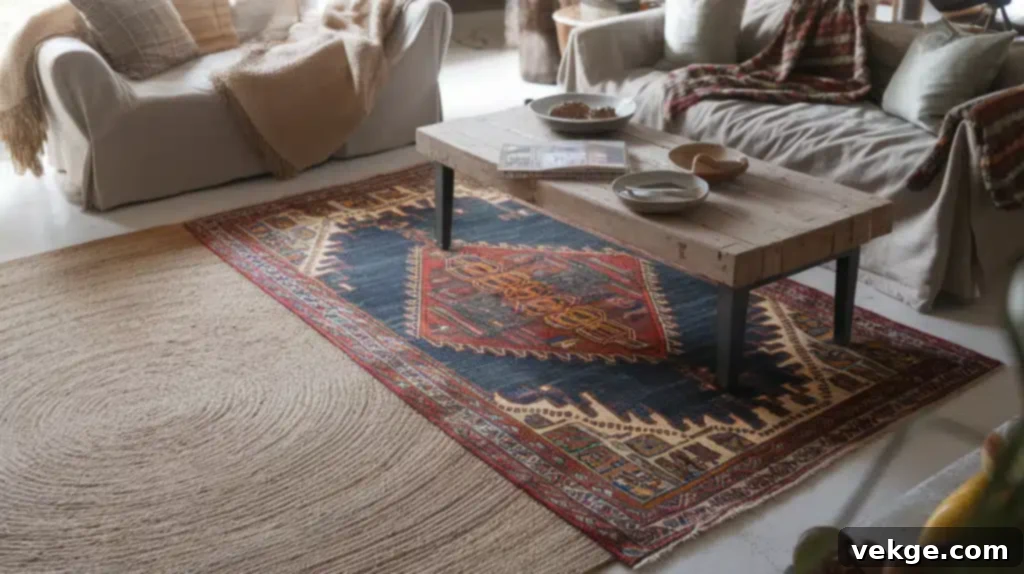
While layering rugs offers incredible creative freedom, there are a few common pitfalls that can detract from an otherwise beautiful design. Being aware of these mistakes will help you achieve a polished, professional, and lasting layered look.
1. Picking the Wrong Size Base Rug: The Under-Sized Foundation
This is, without a doubt, the most frequent mistake I encounter. Homeowners often underestimate the scale required for the base rug, choosing one that’s simply too small to properly anchor the furniture. When your bottom rug is tiny – floating awkwardly in the middle of a seating arrangement – your entire layered setup looks like a tentative afterthought rather than a planned, cohesive design. It fails to define the space, making your furniture feel disconnected. Remember, your base rug needs to be generously sized, extending well beyond your primary furniture pieces to ground the entire conversation area. Even the prettiest top layer won’t look right without a substantial, well-proportioned foundation beneath it.
2. Using Two Thick Rugs Together: A Recipe for Instability
Layering two plush, high-pile rugs might sound incredibly cozy and luxurious in theory, but in practice, it creates more problems than comfort. The combined thickness often results in a wobbly, unstable surface for furniture, making coffee tables uneven and creating a precarious environment. Doors might get stuck, and the uneven terrain becomes a significant tripping hazard, especially for children or the elderly. Furthermore, vacuuming and general cleaning become an arduous, frustrating task. I’ve learned through experience that the most effective and safest approach is to mix pile heights: a low-pile or flat-weave base paired with a thicker, more luxurious top rug works much, much better, offering both aesthetics and functionality.
3. Ignoring Pattern Scale and Conflict: Visual Chaos
Another common misstep is pairing patterns that aggressively compete for attention. When both rugs feature large, busy, and similarly scaled patterns, the eye doesn’t know where to rest, creating visual chaos. The result? Your room can feel overwhelmingly busy, cluttered, and ironically, much smaller than it actually is. The key to successful pattern mixing is contrast. One rug should clearly take the lead with its pattern, while the other plays a supporting role with a more subdued design, a solid color, or a vastly different pattern scale. Think of it as a conversation, not a shouting match.
4. Skipping the Rug Pad: The Hidden Flaw
It’s tempting to try and save a few dollars by skipping the rug pad. “It’s just an extra layer, who will notice?” you might think. Trust me – everyone will notice, eventually. Skipping the rug pad inevitably leads to rugs that bunch up, slide around dangerously, and wear out significantly faster. A good quality rug pad is like the crucial foundation of a house: you can’t see it, but everything else falls apart without it. It provides necessary grip, adds cushioning, protects your floors, and extends the life of both your layered rugs by absorbing impact and preventing friction. It’s a small investment that yields huge returns in safety, comfort, and longevity.
5. Matching Too Perfectly: Missing the Point of Layering
I’ve noticed some individuals trying to match their layered rugs too perfectly – aiming for identical colors, similar patterns, or perfectly aligned edges. While harmony is the goal, exact matching defeats the very purpose of layering! The beauty and intrigue of this technique come from creating interest through deliberate contrast – a play of different textures, complementary colors, and varied patterns. When rugs match too closely, you lose the rich, dynamic, and curated look that makes layering so special. Instead, strive for synergy where each rug contributes a unique element that enhances the overall aesthetic, rather than simply duplicating it.
Conclusion: Embrace the Art of Layering
Congratulations! You now have all the knowledge and inspiration you need to start layering rugs like a seasoned interior design pro. This guide has equipped you with the confidence to transform your living room into a haven of style, comfort, and unique personality.
Remember the core principles:
- Always start with a substantial, solid base rug that’s perfectly sized to anchor your room and furniture.
- Introduce a smaller top rug that brings in captivating patterns, textures, or colors you adore, letting it be the focal point.
- Pay meticulous attention to pile heights, ensuring smooth transitions and functional harmony.
- Never skip the essential rug pad; it’s crucial for safety, stability, and extending the life of your rugs.
- Give both rugs ample room to display their beauty, creating a visible frame that unifies your space.
- Consider traffic flow and seasonal versatility to ensure your layered look is as practical as it is beautiful.
Don’t be afraid to experiment! Mix various textures, play with different patterns and scales, and move things around until you discover the combination that genuinely feels right for your space and reflects your unique taste. Your perfect rug pairing might take a few tries to achieve that just-right, effortlessly chic look, but the journey of discovery is part of the fun.
Have you tried layering rugs in your home? I’d absolutely love to hear about your experiences, what combinations worked wonderfully for you, or any challenges you overcame. Share your insights in the comments below, or better yet, send me photos of your beautifully layered rug setup! Let’s learn from each other and celebrate the art of home styling!
Frequently Asked Questions About Layering Rugs
Can I Layer a Runner Over a Large Area Rug?
Yes, absolutely! Layering a runner over a larger area rug is a fantastic design choice, especially for defining specific zones or pathways within an open-plan living room. It works particularly well along the edge of a seating arrangement to guide movement or to highlight a narrow space, such as in front of a console table or a fireplace. Ensure the runner’s colors and patterns complement the base rug, and use a non-slip pad under the runner to keep it securely in place.
How Do I Clean Layered Rugs?
For routine cleaning, you should generally clean each rug separately. Start by carefully removing the top rug. Then, vacuum both the base rug and the top rug thoroughly, following the manufacturer’s care instructions for each material. For spills or deeper cleaning, address each rug individually based on its specific material (e.g., spot-clean wool, machine-washable cotton, or professional cleaning for delicate fibers). Always ensure both rugs are completely dry before you re-layer them to prevent mold or mildew growth.
Will Layered Rugs Make My Room Too Hot In Summer?
Not necessarily, especially if you choose your materials wisely. While layering does add an extra layer of insulation, you can mitigate warmth during summer months by selecting lightweight, breathable natural fiber rugs for both layers. Opt for materials like cotton, jute, sisal, or thin flatweave wool, which tend to be cooler than thick, high-pile synthetics or plush shags. Alternatively, one of the great advantages of layering is the flexibility: you can simply remove the top layer during the warmer months and reintroduce it when the weather turns cooler, instantly adapting your space for seasonal comfort.
Can I Layer Rugs on Top of Carpet?
Yes, you can! Layering rugs on carpet is an excellent way to add visual interest, define a seating area, introduce color, or even cover up worn patches in wall-to-wall carpeting. When layering on carpet, choose a base rug with a very low pile or flat weave, and ensure it’s large enough to anchor your furniture. It’s even more crucial to use a high-quality rug pad designed for carpet-on-carpet use, which helps prevent slipping and bunching, as rugs can move more easily on a soft carpeted surface. A textured base rug (like jute) can also provide extra grip.
What’s the Best Way to Secure the Top Rug?
To secure the top rug, you have a few options: The most effective method is to use a non-slip rug pad specifically cut to the dimensions of the top rug and placed between the base rug and the top rug. Additionally, some designers use double-sided carpet tape in a few key spots around the edges of the top rug to adhere it to the base rug, though this can sometimes leave residue or be difficult to remove. Ensuring your base rug itself is secured with its own non-slip pad is the first line of defense, as a stable foundation helps keep everything else in place.
